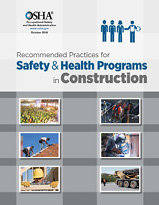The Occupational Safety and Health Administration has released Recommended Practices for Safety and Health Programs in Construction to help industry employers develop proactive measures keeping their workplaces safe. The recommendations may be particularly helpful to small- and medium-sized contractors who lack safety and health specialists on staff.
|
|
| Recommendations are advisory only and do not create any new legal obligations or alter existing obligations created by OSHA standards or regulations. The document can be obtained at www.osha.gov. |
Safety and health programs encourage finding and fixing workplace hazards before they cause injuries, illnesses and deaths, agency officials note; implementing these programs also helps reduce the financial difficulties these events can cause for workers, their families and their employers. Contractors can create a safety and health program using a number of simple steps that include training workers on how to identify and control hazards; inspecting the jobsite with workers to identify potential problems with equipment and materials; and, developing responses to possible emergency scenarios in advance.
“The recommendations will help contractors prevent injuries and illnesses on their construction sites and make their companies more profitable,” says Assistant Secretary of Labor for Occupational Safety and Health Dr. David Michaels. The recommended practices for a safety and health program are flexible and can be adjusted to fit small and large construction companies handling short-term or multi-year projects, he adds. Working with employees to implement a program can offer other benefits, including improvements in production and quality; greater employee morale; improved employee recruiting and retention; and, a more favorable image and reputation among customers, suppliers and the community.
WALKING-WORKING SURFACES, PERSONAL FALL PROTECTION
A final rule updating OSHA general industry Walking-Working Surfaces standards specific to slip, trip and fall hazards includes a new Personal Protective Equipment section establishing employer requirements for fall protection systems. The rule’s most significant update is allowing employers to select the system that works best for them, choosing from a range of accepted options including personal fall protection devices. OSHA has permitted the use of personal fall protection systems in construction since 1994 and the final rule adopts similar requirements for general industry. Other changes include allowing employers to use rope descent systems up to 300 feet above a lower level; prohibiting the use of body belts as part of a personal fall arrest system; and, requiring worker training on personal fall protection systems and fall equipment.
“The final rule will increase workplace protection from those hazards, especially fall hazards, which are a leading cause of worker deaths and injuries,” says Dr. Michaels. “OSHA believes advances in technology and greater flexibility will reduce worker deaths and injuries from falls.” The final rule increases consistency between general and construction industries, he adds, which will help employers and workers involved in both categories.
OSHA estimates the final standard will prevent 29 fatalities and 5,800-plus injuries annually. Effective this month, the rule will cover approximately 112 million workers at 7 million sites.
SILICA EXPOSURE SAFETY BULLETIN

